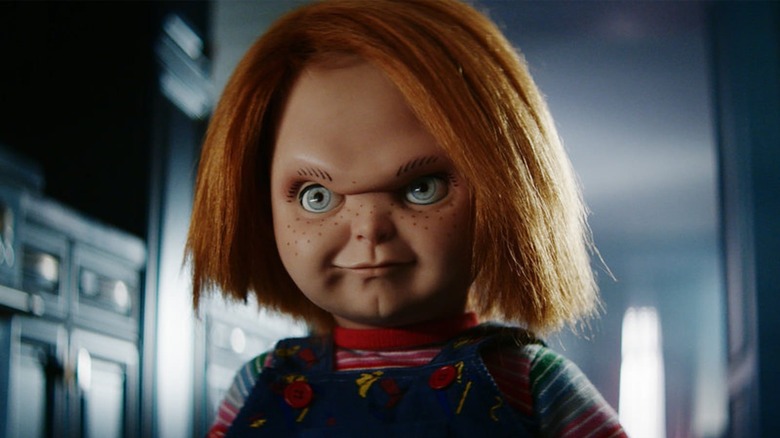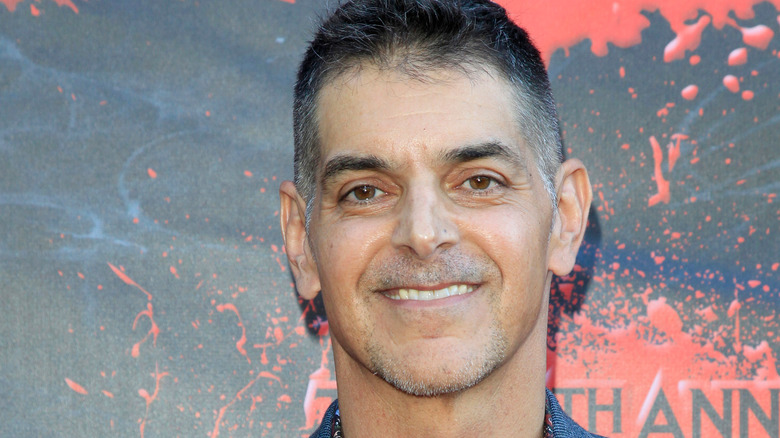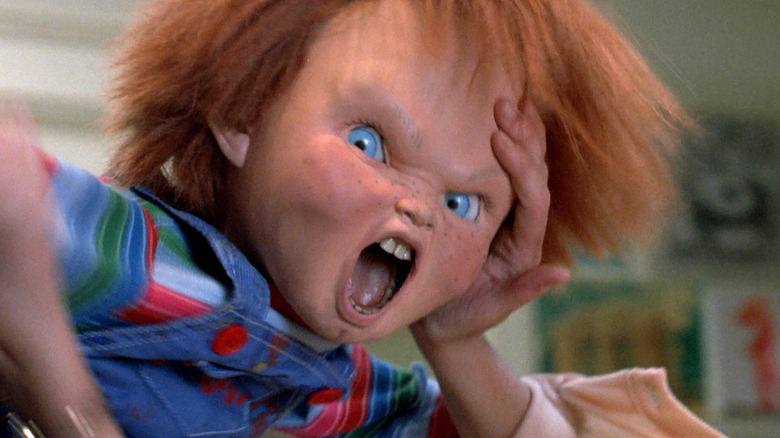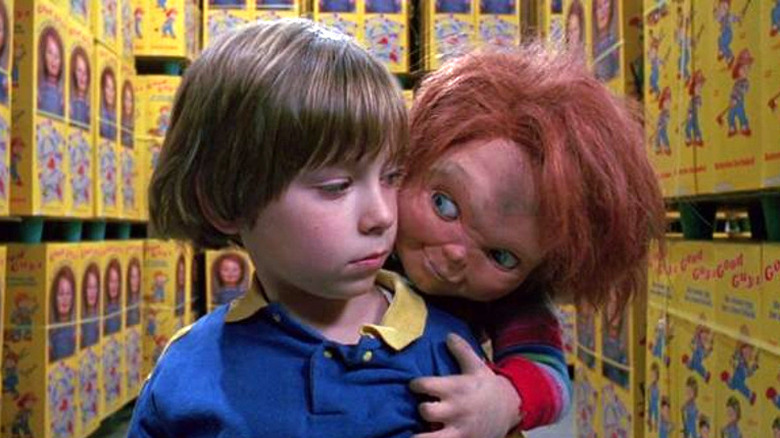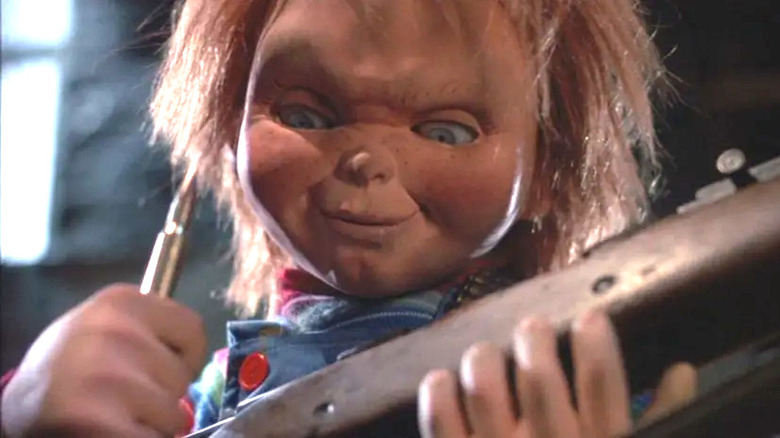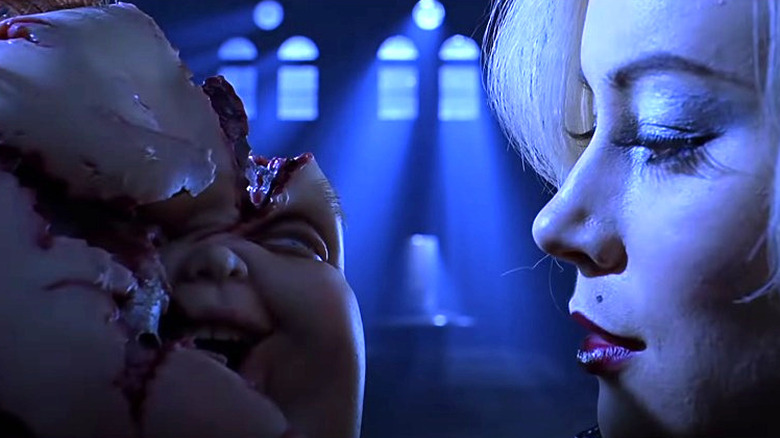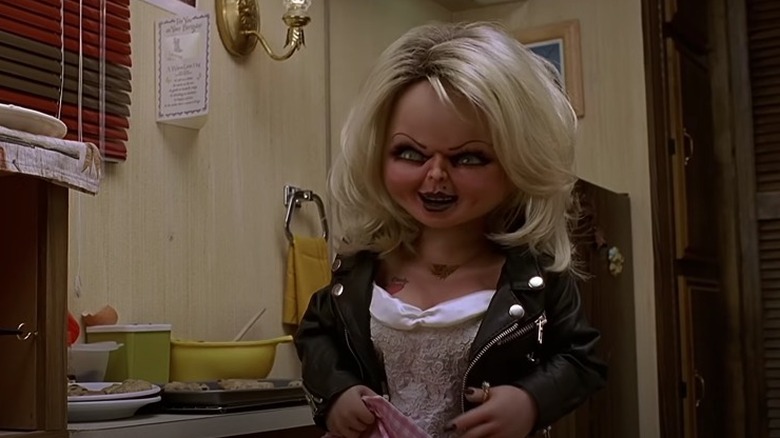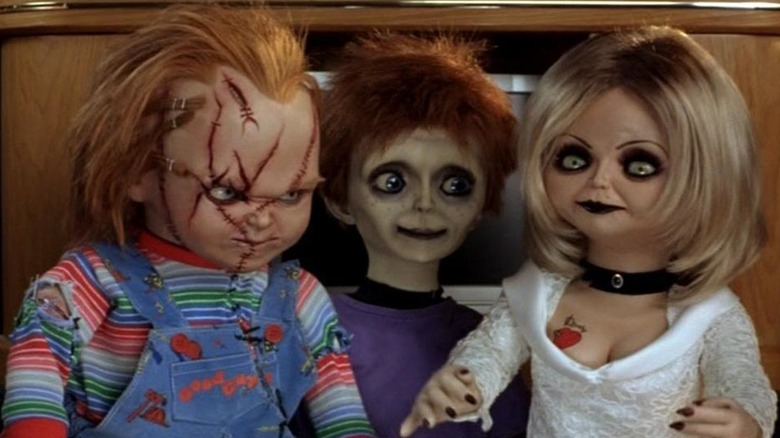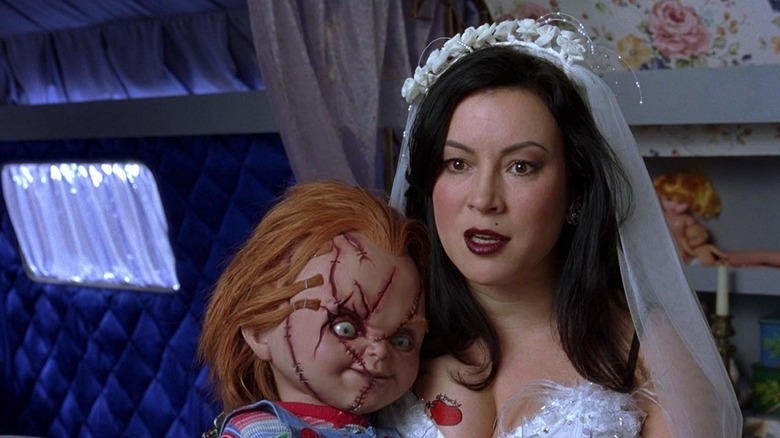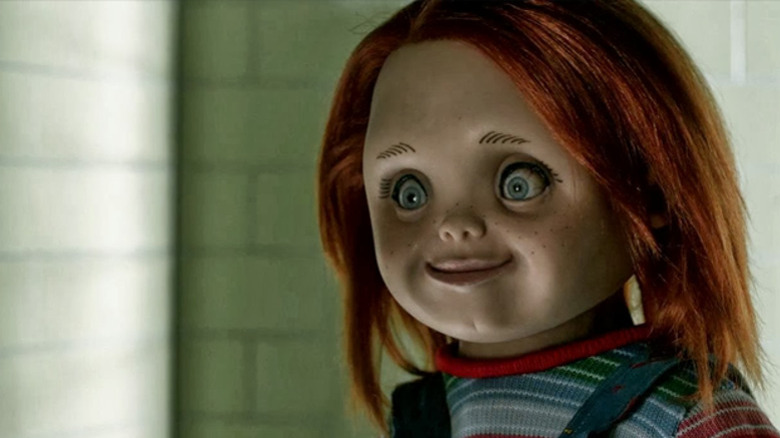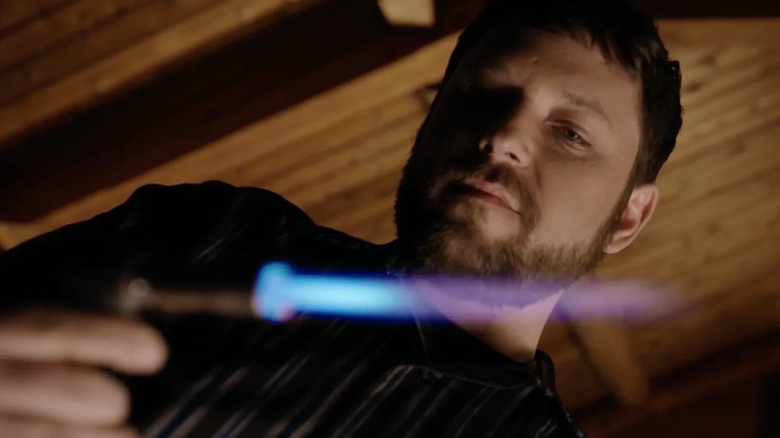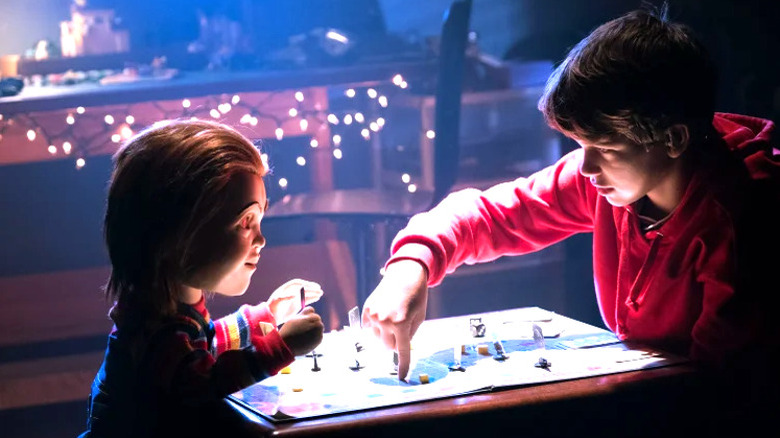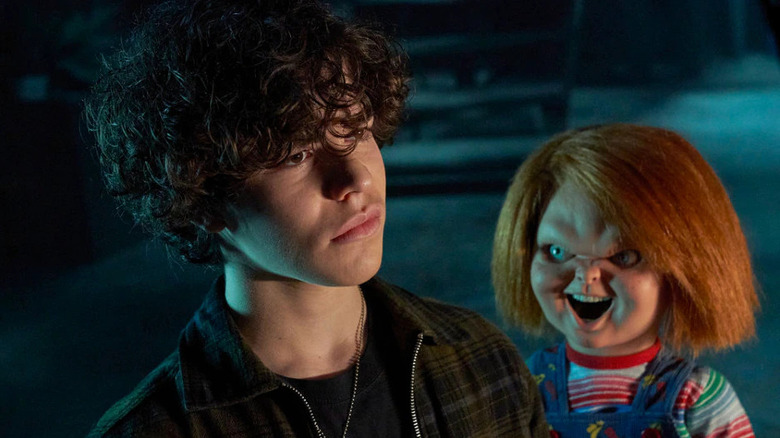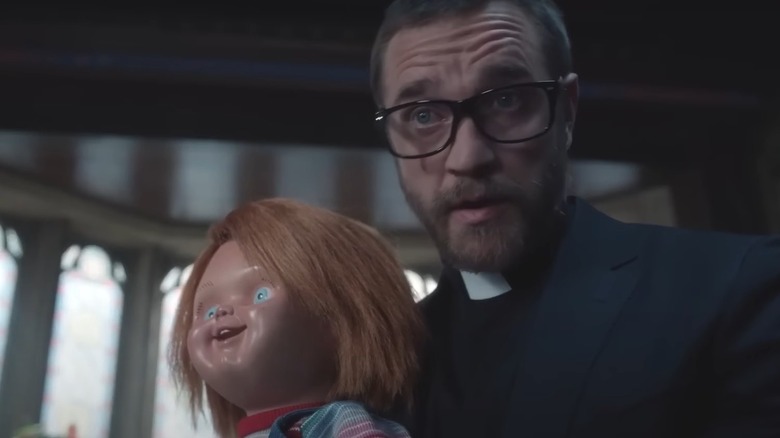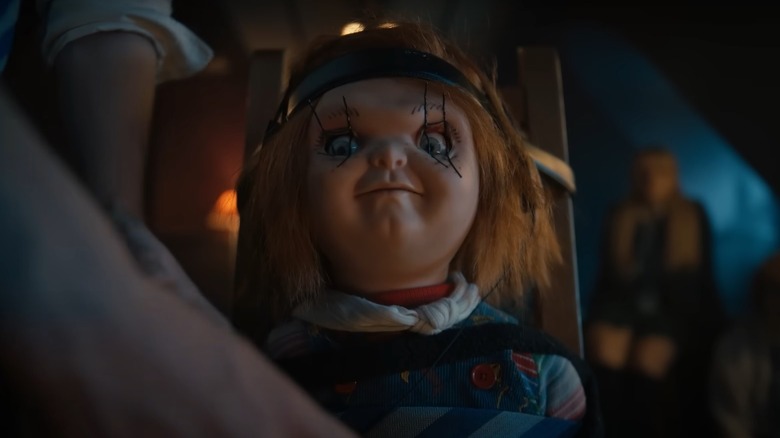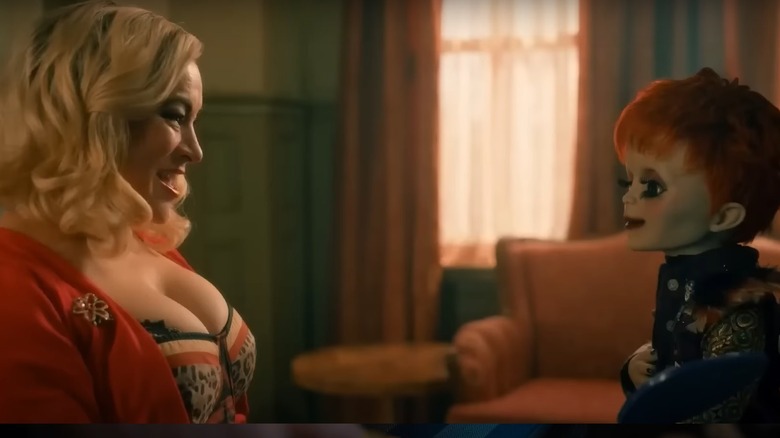The Entire Story Behind Child's Play Explained
Chucky has been delightfully slashing his way across our screens and into our hearts for more than three decades now. Over the course of seven movies, a reboot, and a television series, the possessed doll with a foul mouth and a fetish for slaughter has grown into one of the most complex and entertaining movie monsters in the history of the silver screen. What started as a tense horror movie with a fun concept has turned into a franchise with surprisingly progressive themes, a twisted sense of humor that often deals with self-parody, and a testament to one man's creative vision.
Instead of recapping the events featured in each film, let's take a look at the fascinating behind-the-scenes stories that led to the enduring legacy of the "Child's Play" and "Chucky" saga. It is the story of two immensely talented people and their stalwart loyalty to a franchise that they rightfully could have abandoned years ago. But it's also about how their shared vision created a character and mythology that refuses to become irrelevant, while continuing to challenge the public perception of what horror can and should be.
The birth of Chucky
UCLA film student Don Mancini wrote the script that would become "Child's Play" in 1985. Originally conceived as a satire of the marketing industry, the screenplay was about a doll who became the manifestation of a repressed little boy's id, carrying out brutal vengeance on anyone the child held malice for. Originally titled "Batteries Not Included," it was changed to "Blood Buddy" to avoid conflict with a Steven Spielberg-produced movie of the same name.
Around this time, producer David Kirschner was looking for a new project. Having always been fascinated and frightened by dolls, he was interested in making a film about them. Kirschner got his start as an illustrator for Jim Henson before producing the wonderful animated film "An American Tail." In the supplemental material included on the "Child's Play" DVD, he explained that he was given a development deal with Disney under the assumption that he would continue to produce family-friendly entertainment. The first project he presented to them was "Blood Buddy."
While the movie did not end up getting made by Disney, Kirschner did not give up. Taking Mancini's general description in the script for the Good Guy doll, he designed the figure that we have come to know as Chucky. Feeling the script needed some changes, he brought on "Fright Night" filmmaker Tom Holland (not Spider-Man) and the late screenwriter John Lafia to take another pass at the material.
Say hello to Chucky
While talking about '80s horror movies with Daily Dead, Tom Holland explained that every director turned down "Child's Play," saying, "It was considered to be such a stupid, cheesy, exploit-y premise that nobody wanted to do it." After signing on, Holland was tasked with making the audience believe that the doll was truly evil, so he created the character of serial killer Charles Lee Ray. The rewrites also resulted in bizarre voodoo mythology that Don Mancini wasn't thrilled with, but had to accept.
Holland brought Chris Sarandon with him from "Fright Night" to play police officer Mike Norris, future "7th Heaven" actress Catherine Hicks was hired as Andy's mom Karen and Andy himself was played by young actor Alex Vincent. In his audition, Vincent continuously pretended to forget a line because he did not feel comfortable cursing. The actor believes it was his ability to convince the producers that he forgot the line which lead to him getting the role.
Brad Dourif, probably best known at the time for his role in the classic "One Flew Over The Cuckoo's Nest," was cast as Charles Lee Ray. He physically portrayed Chucky the doll in rehearsals as well, although another actor was brought in to voice the character in post-production. Audiences didn't respond well, however, so Dourif was brought back. With the exception of the remake, he has been playing Chucky ever since.
Sorry, Jack, Chucky's back
Mancini was brought back to pen the script for "Child's Play 2," with the first film's co-screenwriter, John Lafia, signing on to direct. Both men agreed it would be best to minimize the voodoo mythology as much as possible and only used it when the plot required it. The sequel also gave Mancini the chance to bring back certain elements from his original draft, like the climax taking place in the very factory where the doll was assembled.
Producer David Kirschner wanted to push the special effects envelope even further. In the production notes included on the DVD, special effects artist (and spouse of Catherine Hicks) Kevin Yagher said, "In order to make Chucky's speech more realistic, we shot the film at 18 frames per second instead of 24 when Chucky is talking." This allowed them to slow things down and sync the dialogue with the mouth movements more effectively.
In the film, Andy is taken in by a foster family since his mother has been committed to an asylum following the events of the original. He forms a bond with his older foster sister Kyle, who would return later in the series. Kyle was played by actress Christine Elise. It was her first big film role and she told Indie Mac User that she loved every minute of it. Later in life, Alex Vincent told her he remembered her as the person who was nicest to him.
In the Army now
Released on August 30, 1991, "Child's Play 3" hit theaters only nine months after its predecessor. Strangely, though, the character had been aged up quite a bit. In this third film, Andy Barclay isn't a traumatized little kid but a teenager in military school. Don Mancini (again returning to write the script) explained the creative decision, jokingly comparing it to a common trope of rapidly aging characters in soap operas.
The intention was to avoid becoming repetitive by having every movie be about Chucky going after the same little boy, while developing Andy more as a character. According to that same interview, Mancini also liked the idea of setting the film in a rigidly structured setting like a military academy because it gave Chucky more authority figures to go after, similar to his original conceit for the series.
The film garnered some controversy in the U.K. when it was baselessly cited as the inspiration for a horrendous murder. It wasn't very well received critically either. According to Rotten Tomatoes, it is still the most poorly reviewed installment of the series. It would be another seven years before we got another movie starring Chucky, but after the next film, the series would never be the same.
Chucky in love
Following the success of "Scream," the horror genre was reinvigorated. Not only did several copycat movies trying to cash in on the film's high concept, but there was a concentrated effort to be self-referential, meta, and more stylized. It was in this new atmosphere that 1998's "Bride of Chucky" was able to take the "Child's Play" franchise in a bold new direction.
David Kirschner credits the cover art for a video of "The Bride of Frankenstein" as inspiring him to discuss the possibility of creating a love interest for Chucky with Don Mancini. Like the classic Universal horror sequel, there would be more humor this time around as well. Regarding the more comedic tone of the film, Don Mancini said he structured it like a romantic comedy by making it about misunderstandings between characters who keep getting themselves "into pickles."
To kick the visual style way up, director Ronny Yu was brought in. At the time, he had been known for his film "The Bride with White Hair" and he connected with the visual descriptions in the script, feeling it was very similar to his directing style. Having a second doll also presented new technical challenges, with an even bigger team of puppeteers, and Tiffany's slender design leaving very little room for the motors and wires required to operate her. It was worth it, however, as Tiffany has proven to be an indelible character for the franchise going forward.
The diary of Chucky's bride
Don Mancini wrote the part of Tiffany for Jennifer Tilly, even though he didn't know her at the time. According to Jennifer Tilly's diary, which was included in the special features for the "Bride of Chucky" DVD, she wasn't overly thrilled with the idea at first. After calling her manager to find out why she hadn't had a job recently, she found out that there was an offer coming through for a horror movie about a killer doll. She knew it was Chucky right away and thought that would be the end of her career.
She and her manager ended up asking for a dollar amount that they didn't think the producers would go for. She liked the idea of working with director Ronny Yu but knew that a friend of hers wanted the part and didn't think the production would agree to her salary quote anyway. To her surprise, however, they did agree and Jennifer Tilly entered the "Chucky" universe.
Her writings indicate that the work she did on set was difficult because of the uncomfortable clothing they put her in, an awkward dance scene, and a killer migraine, but she mostly enjoyed the experience. Most of her work was done in the recording studio with Brad Dourif and she seems to have had a blast working with him. After running into Dourif on a plane, the two agreed that working on a "Chucky" movie was a pretty sweet gig.
Evil family matters
Despite the success of "Bride of Chucky," it wasn't until November 2004 that "Seed of Chucky" was released. Don Mancini started writing it immediately following the release of "Bride," but the horrific massacre at Columbine High School made the studio nervous since the film featured murderous parents trying to bring their child into the family business.
As producer Corey Sienega pointed out in the making-of featurette "Conceiving the Seed of Chucky," "Bride" embraced the inherent silliness of the concept and pushed the humor and horror together. That same sensibility is supercharged in "Seed," as the filmmakers blatantly mocked themselves by making the movie about Jennifer Tilly starring in a "Chucky" movie as Tiffany, with the actual Tiffany trying to transfer her soul into the actress' body.
The iconic John Waters was brought into the film because of his love for the Chucky character. Mancini found out about that love when Justin Whalin (who played Andy in "Child's Play 3") worked on Waters' film "Serial Mom" and discovered that he had a Chucky doll in his bathroom. Rap artist Redman plays himself in the film as well. Mancini liked his performance but mentioned that he initially imagined Quentin Tarantino in that slot.
"Seed of Chucky" is a special installment in the series as it sees Mancini stepping up as writer and director for the first time. It also made Chucky a father of a pacifist gender-fluid child named Glen/Glenda, a kind of representation that would continue later in the franchise.
Revenge of the diary of Chucky's bride
Jennifer Tilly's diary was also included with the special features of "Seed of Chucky." She was excited to return, but money negotiations got in the way. When she heard that they might replace her with an actress from "Baywatch," she signed on. She details some of the strife Mancini experienced trying to get the movie made. Not only did the school shooting give the studio cold feet, but Mancini's script made them nervous as well.
They felt the script was too funny, too gay, and there was too much Jennifer Tilly. She, of course, took offense to that last one. Apparently, the studio wanted a scary movie and not a farce, so the film was shelved. She attended the premiere of "Freddy vs. Jason" with Mancini to support their friend Ronny Yu, and because Mancini felt that if the film was a success it would get "Seed of Chucky" greenlit. The movie opened and "Seed" got the green light the next day.
Tilly's experience on this film was significantly harder. Playing a version of herself was much more demanding, the technical aspect of the puppet work was far more rigorous, and the shooting process was generally grueling. Both she and Mancini joked about not returning for a sequel at one point because they were so exhausted by the production. However, when Tilly wrapped on the film, everyone on set cheered and applauded her performance so much that she cried with gratitude.
A tonal reboot
It was another nine years before we saw another "Chucky" movie. During that time, Don Mancini and David Kirschner explored the possibility of rebooting the series and remaking the first movie. However, confusion about the rights to that 1988 film and the waning interest in horror remakes made them decide to reboot the tone of the series rather than the entire franchise. 2013's "Curse of Chucky" is a darker, more atmospheric, and scarier movie than most of its predecessors.
Part of that tone is communicated by the set itself. Mancini set the majority of the film in an old Victorian-style house that he needed to be what he described as "a reflection of the characters' lives." The movie was filmed in Winnipeg and while the spooky interior of the house was created in a studio, the exterior was actually a bed and breakfast that Mancini found online after Googling "Manitoba Victorian architecture."
Not only does the film tie back to the legacy of the previous entries by bringing back Jennifer Tilly and Alex Vincent in the finale, but Brad Dourif's daughter Fiona Dourif was cast as the kind, wheelchair-bound character Nica. Mancini saw a lot of actresses for the part, but none of them nailed the role like Fiona, proving it wasn't nepotism — even though Brad Dourif was very happy that she joined the cast.
Andy Barclay returns
Thankfully, only four years passed before "Cult of Chucky" was released. The 2017 sequel picked up where "Curse" ended. Andy is now in possession of a Chucky doll that he can make suffer for all the trauma the evil toy has put him through, while Nica is locked away in an asylum. The setting was appealing to Mancini because he felt that if an inmate at this kind of facility were to suddenly claim that a doll was talking to them, no one would believe it.
The movie also takes a leap that Mancini had been trying to do for a while, which is the concept of multiple Chucky dolls. By possessing multiple Good Guy dolls, Charles Lee Ray is able to cover more ground and wreak more havoc than previously seen. This presented several technical challenges, of course. Luckily, the film was extensively storyboarded, meaning the puppeteers and the rest of the crew had a detailed blueprint of how to make everything work.
In one of the biggest cliffhanger endings in the series thus far, we learn that Chucky has passed his soul into Nica's body. For the first time in decades, Charles Lee Ray has a human body again, and this time he is played by Fiona Dourif. Therefore, Fiona is playing a character created by her father that is now controlling the body of a character she originated. As meta as that is, and as exciting as it was for the actors, it was about to get even stranger.
An actual reboot
The rights to the original "Child's Play" were owned by two studios, MGM and Universal. A man named Christopher Skase attempted to purchase MGM/UA (United Artists) in 1989 but was not interested in letting the studio make horror movies. So the studio gave Kirschner the rights for the sequels and shared the rights for the original film. Kirschner went on, with the help of Steven Spielberg, to get "Child's Play 2" set up at Universal and they've been working together ever since.
Skase's deal fell through and he eventually died in 2001. But MGM/UA still had the rights to do whatever they wanted with the concepts and characters featured in the original "Child's Play." They approached Mancini and Kirschner to see if they were interested in being involved, but they were not. They were still actively working on developing their own series of Chucky-related material and didn't like the idea of the market suddenly becoming confused. If anything, Mancini was straight up offended.
The movie cast the excellent Mark Hamill as the voice of Chucky and changed the lore almost entirely, with no connection to the other films whatsoever.
Chucky comes home
Mancini and Kirschner expanded Chucky's world even further in the series "Chucky," which premiered in 2021 on Syfy. Instead of just picking things up with Nica/Chucky and Jennifer Tilly/Tiffany in the car planning their next move, the focus moved to Charles Lee Ray's hometown of Hackensack, New Jersey. The show made a conscious effort of moving into the realm of YA by having Chucky manipulate a young LGBTQ+ character named Jake (Zackary Arthur).
Their relationship very much mirrors Mancini's "Blood Buddy" concept, with Chucky intentionally going after the people that make Jake's life difficult. The LGBTQ+ representation is also front and center as it embraces Chucky's status as a sexually fluid character who has fathered a non-binary child. More importantly, though, Jake's relationship with Devon (Björgvin Arnarson) is the kind of honest depiction of a young gay romance that Mancini has always wanted to see.
Season 1 explores Charles' origin, with Fiona Dourif playing a young Charles Lee Ray and meeting the character of Tiffany for the first time. Andy Barclay was also back, alongside his foster sister Kyle, with the two of them hunting down as many Chucky dolls as possible. The whole series is a loving testament to the continued ingenuity of Mancini and Kirschner, the fans, and the bright future still to come.
Back to where it all began
Jake and his friends return for another adventure in Season 2 of "Chucky." After the events of Season 1, Jake has gone to live with a new family, and has a new foster brother named Gary. Unfortunately, this new life is not to last. Chucky tracks down Jake and kills his foster brother with an explosive. This leads to Jake, Devon, and Lexi being blamed for his death, and sent to a Catholic rehabilitation clinic called the Catholic School of the Incarnate Lord. The twist is that the school is housed in the same building that used to be the boarding school where Charles Lee Ray grew up.
By setting much of Season 2's story in the same building that Charles grew up in, "Chucky" sets out to bring the "Child's Play" franchise full circle by further exploring Charles' upbringing and helping audiences learn more about the events that led to him becoming the Lakeshore Strangler. The season achieves this by delving into his relationship with his childhood psychiatrist Dr. Mixter (Rosemary Dunsmore), who nurtures his murderous ways rather than trying to subdue them. This important relationship between psychopath and psychiatrist is a staple of many stories surrounding fictional serial killers. Dr. Mixter's nurturing of Charles' violent behaviors mirrors that of many other psychiatrist and killer relationships in television, such as Dr. Evelyn Vogel's relationship with Dexter in "Dexter."
Is a Good Chucky possible?
The third episode of Season 2, titled "Hail Mary," introduces a concept never before done in the "Child's Play" franchise thus far. Is it possible for there to be a good Chucky? After all, the in-universe brand name for the dolls that Chucky inhabits are Good Guy dolls. In "Hail Mary," Jake and his friends test this theory out. After capturing Chucky, he refuses to reveal anything about his plots against them. So they tie him down, pry his eyes open (in a very clear homage to "A Clockwork Orange"), and use aversion therapy to try to make Chucky docile and more receptive to their suggestions. Shockingly, the plan actually works: the doll begins going by the name Good Chucky and helps defend the teens from another evil Chucky that arrives.
Interestingly, this is not the first time that creator Don Mancini had the idea to introduce a Good Chucky. Mancini revealed that he'd originally come up with the idea for "Seed of Chucky," but the concept never made it into the film. However, he felt like Season 2 was the perfect time to bring Good Chucky to life, since the Catholic setting allowed for a thematic focus on redemption. In addition, it allowed the kids to have more scenes with Chucky without leading to a life and death situation.
Chucky vs. Tiffany
Chucky might still have it out for the show's leading trio of teenagers, but his feud with Tiffany is arguably Chucky's primary focus, especially in the final third of the season. Chucky and his ex-wife have a complicated past, and ever since her introduction in "Bride of Chucky," Tiffany has shaken up the dynamic between Chucky and his victims, throwing a third party into the mix. The feud between the two in "Chucky" Season 2 opens the door for some wacky antics, including a scene where Tiffany is mistaken for actress Jennifer Tilly (who plays Tiffany), and attends a surprise party thrown for her that also includes her sister, Meg Tilly. Jennifer revealed that it was the first time she'd worked with her sister since high school.
The twin children of Chucky and Tiffany, Glen and Glenda, also play an important role in the show. Originally, in "Seed of Chucky," Glen and Glenda were a doll named Glen, who had two personalities, one that was male and benevolent and one that was female and murderous. The film ends up splitting the personalities between two human babies, a choice that has long been controversial. However, in "Chucky," Don Mancini aims to create a story that embraces queer representation, and eventually has the twins return to the Glen/Glenda doll as one merged being (now going by G.G.). Mancini told Gizmodo, "It was really important to us that we honor the trans experience through our own cockeyed metaphorical lens."
